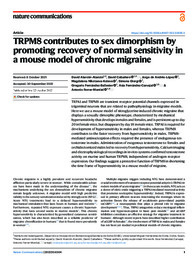Por favor, use este identificador para citar o enlazar este ítem:
https://hdl.handle.net/11000/35236
TRPM8 contributes to sex dimorphism by
promoting recovery of normal sensitivity in
a mouse model of chronic migraine
Título :
TRPM8 contributes to sex dimorphism by
promoting recovery of normal sensitivity in
a mouse model of chronic migraine |
Autor :
Alarcón Alarcón, David 
Cabañero, David 
de Andrés López, Jorge 
Nikolaeva-Koleva, Magdalena 
Giorgi, Simona 
Fernández Ballester, Gregorio
Fernández Carvajal, Asia
Ferrer-Montiel, Antonio  |
Editor :
Nature Research |
Departamento:
Departamentos de la UMH::Bioquímica y Biología Molecular |
Fecha de publicación:
2022-10-22 |
URI :
https://hdl.handle.net/11000/35236 |
Resumen :
TRPA1 and TRPM8 are transient receptor potential channels expressed in
trigeminal neurons that are related to pathophysiology in migraine models.
Here we use a mouse model of nitroglycerine-induced chronic migraine that
displays a sexually dimorphic phenotype, characterized by mechanical
hypersensitivity that develops in males and females, and is persistent up to day
20 in female mice, but disappears by day 18 in male mice. TRPA1 is required for
development of hypersensitivity in males and females, whereas TRPM8
contributes to the faster recovery from hypersensitivity in males. TRPM8-
mediated antinociception effects required the presence of endogenous testosterone in males. Administration of exogenous testosterone to females and
orchidectomized males led to recovery from hypersensitivity. Calcium imaging
and electrophysiological recordings in in vitro systems confirmed testosterone
activity on murine and human TRPM8, independent of androgen receptor
expression. Our findings suggest a protective function of TRPM8 in shortening
the time frame of hypersensitivity in a mouse model of migraine.
|
Área de conocimiento :
CDU: Ciencias puras y naturales: Biología |
Tipo de documento :
info:eu-repo/semantics/article |
Derechos de acceso:
info:eu-repo/semantics/openAccess |
DOI :
https://doi.org/10.1038/s41467-022-33835-3 |
Publicado en:
Nature Communications | (2022) 13:6304 |
Aparece en las colecciones:
Artículos Bioquímica y Biología Molecular
|
 La licencia se describe como: Atribución-NonComercial-NoDerivada 4.0 Internacional.
La licencia se describe como: Atribución-NonComercial-NoDerivada 4.0 Internacional.
 La licencia se describe como: Atribución-NonComercial-NoDerivada 4.0 Internacional.
La licencia se describe como: Atribución-NonComercial-NoDerivada 4.0 Internacional.
.png)
